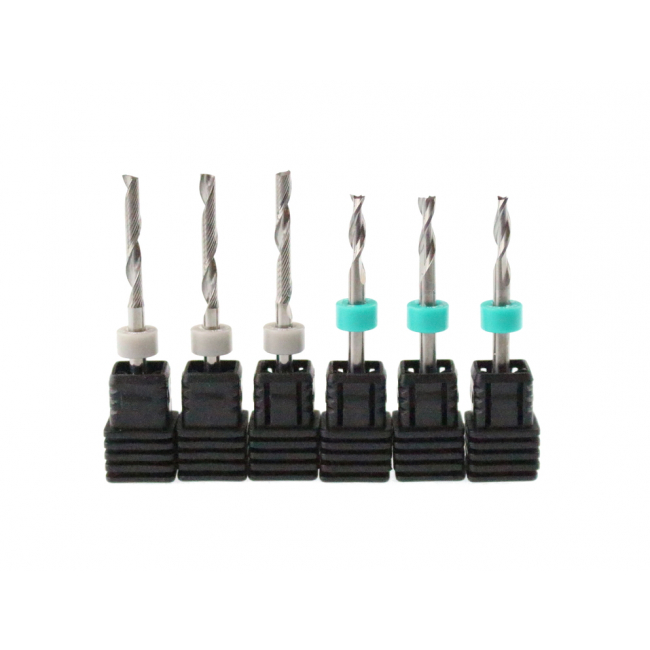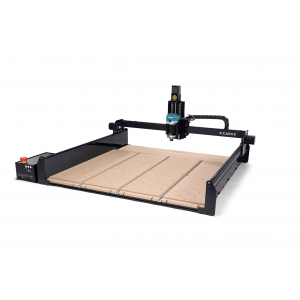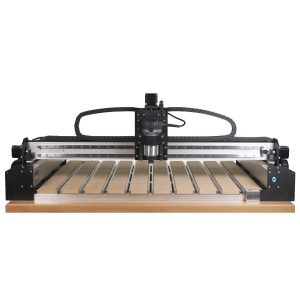Bit Set for Soft Metals (1/8" shank)
This set of 6 bits is great for general purpose soft metal cutting. Bits have a shank diameter of 1/8 inch
This pack contains
| Qty | Type | Cutting Length | Overall Length |
| 3 | Solid Carbide 1F Spiral Upcut | 0.866" | 1.772" |
| 3 | Solid Carbide 2F Fish Tail Upcut | 0.394" | 1.5" |
Choosing Your Milling Bit
End mills, also called milling bits, are the most commonly-used bits used with CNC machines. They are designed to cut horizontally (laterally) across a surface. (Drill bits cut into or through a piece of material.) End mills come in a variety of styles and are designed to help you get the desired effect for your specific project.
If you're new to CNC machines and carving, the information below outlines the various qualities of bits. Understanding what different bits do and how they work can help you choose the right bit for your project.
Please keep in mind that the type of material you're using with your machine is the most important factor in determining what bit you should use. Different materials have different qualities that impact your carving and your bit's behavior.
Shank Diameter vs. Cutting Diameter
The shank diameter is the diameter of the non-cutting part of your bit. This end of the bit is inserted into your router. Many routers are designed to hold a specific diameter bit. For instance, the DeWalt 611 router holds bits that are 1/4" in shank diameter. If you want to use bits that have a smaller shank diameter, you'll need to buy a collet and nut adapter for your router. Inventables'1/8" collet adapter for the DeWalt 611 is a common upgrade many of our customers make as they start doing more complicated, detailed work.
The cutting dimeter is the overall cut diameter of your bit. Cutting diameters can range anywhere from a few inches (for leveling surfaces) to 1/64" or 1/32" (for very fine details). When selecting the right bit for your project, aim to select a bit with the largest possible cutting diameter for your job. If your job has detailed elements that cannot be cut by your selected bit, Easel will recommend you select a smaller bit.
Shank diameters and cutting diameters are not always the same . It is most important to make sure your bit fits in your spindle/router (shank diameter) and then use choose the bit with the right cutting diameter for your project.
Up-Cut, Down-Cut, and Compression
The cutting style of a milling bit identifies which way the material chips are removed from your project, in addition to which side of the cut surface is smoothed.
Up-cut bits expel the cut material upward and smooths the bottom of the cut pass. It pulls heat away from the bit, and is a good choice for plastics, metals, or other materials that are prone to melting or burning. However, because of the bit's design and upward-pulling motion, it can fight the clamping system you use with your material, especially if your material is thin.
Down-cut bits push the chips downward (towards the material). This cutting style is prone to melting or burning your material, especially if your job requires many passes. The benefit to this style of bit is that, by pressing down against the material, it can help thin materials remain secured to your cutting surface. Additionally, the top edges of your cuts will be smoother than if you use an up-cut bit.
Compression bits have a primarily "neutral" cutting action and smooths both the top and bottom edge of the cut pass. This is achieved by the lower part of the bit utilizing the up-cut style, and the upper part of the bit utilizing the down-cut style. As a result, these bits are recommended primarily for thicker materials which will be cut through entirely. If your project requires shallow cuts, it may not be the best choice because only the bottom (up-cut) portion of the bit will be used, and the top (down-cut) portion of the bit will not be used to finish the smoothing.
Flutes
Flutes are the cutting edges on a bit. Fluted bits get their names based on the number of flutes present on the bottom of the bit (for instance, our 2-flute bits all have two cutting edges).
Generally speaking, more flutes on an end mill means a smoother edge finish. More flutes also means there is a smaller surface area to eject cut chips away from your stock material. This means you will need to use a slower feed rate, so the bit has time to properly dispose of the cut materials. By using fewer flutes, you can remove material quicker but will have rougher edges on your cuts.
Certain materials require you to remove material faster than others. For instance, a soft plastic like HDPE will melt if the chips are not expelled from the bit quickly enough. You will want to use a single or 2-flute end mill for a material this soft. For harder materials less prone to melting, you can use more flutes: just be careful with your cut depth, so you don't break the bit by trying to carve too deeply into a hard material.
V-Bits
V-bits, or v-carve bits, create a pass shaped like a "v" and are commonly used for detailed engraving. You can use v-bits in Easel Pro to create intricate v-carved designs. All X-Carve and Carvey users can carve with Easel Pro's v-carving features for free during four (4) days of their choosing every month. Anyone with an Easel account can design projects with Easel Pro features. for free.
Fishtail Bits, Ballnose Bits, and Speciality Bits
The tip of a milling bit helps determine its purpose. Fishtail bits produce a flat surface at the bottom of your cut. Ballnose bits create a rounded bottom of your cut. These bits are ideal for 3D contouring or stepped layers, as the rounded tip reduces ridged edges in consecutive passes.
| Manufacturer | Inventables |
|---|








